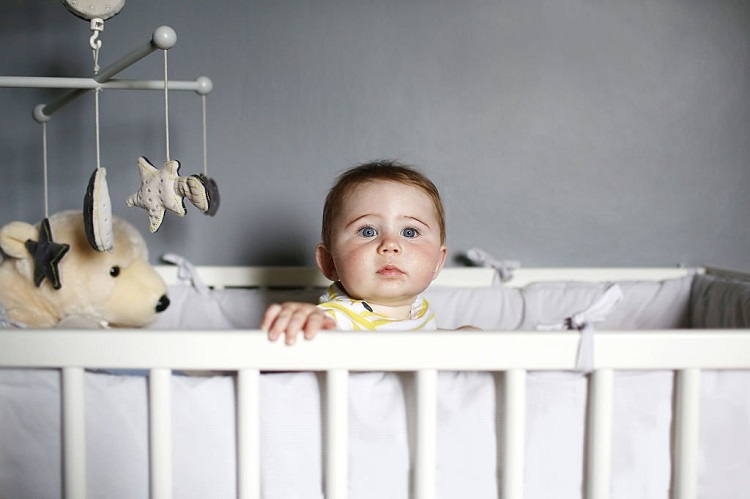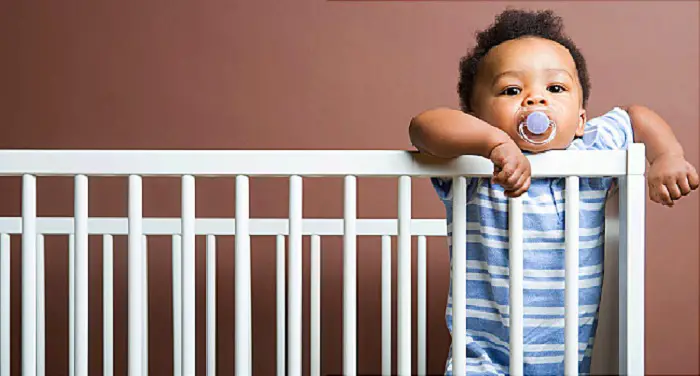Your little one is growing, but you aren’t sure when to lower crib? Selecting your baby’s crib is one of the most important decisions you’ll make as a new parent.
Know that a baby that learns to sit today can learn to pull up and stand tomorrow.
So you should lower the crib to the bottom level when your baby can sit up, roll over, or push up onto their hands and knees.
Keep Reading, as we’ve got the low down and the information you need.
Table of Contents
- When To Lower Crib?
- When To Choose Crib Mattress Height?
- How To Lower Crib Mattress
- Crib Mattress Safety Tips To Apply
- Conclusion
When To Lower Crib?

Once your baby can sit up, roll over, or push up onto their hands and knees, you should lower the crib mattress to the bottom level.
Simple modifications like this can greatly affect whether your child attempts climbing out of his or her crib. This will reduce the risk of falls and injury.
About 10,000 children younger than two years old per year are taken to the emergency room, of which 83.2 percent were specifically related to jumping or falling out of cribs. Hence, knowing when to lower crib is highly important as a parent.
Lowering your baby’s crib mattress is perfectly safe. It makes their crib even safer when the time is right as your baby grows.
Read Also: How To Stop Baby From Climbing Out Of Crib?
When To Choose Crib Mattress Height?

You don’t have to adjust the crib height to the lowest setting immediately, but you do want to lower it as soon you notice that your little one can sit up.
The following guidelines will help you decide when to use each crib mattress height.
High Crib Mattress Setting
For newborns under 5 months, always keep the crib mattress in the highest position. This position is safe as long as your baby can not sit up.
Middle Crib Mattress Setting
This setting is best used for babies between 5 and 8 months of age. At that age most babies start moving on their own.
This includes rolling, sitting unsupported, and pushing themselves onto their hands and knees. This setting helps reduce the risk of falls and injury.
Lowest Crib Mattress Setting
Lower the crib mattress to the lowest setting as soon as your baby shows any signs of pulling themselves up to a standing position. This setting also helps reduce the risk of falls and injury.
How To Lower Crib Mattress
Always remember to check the manufacturer’s instructions via paper or online because this can be a little more complex than raising it on an incline, but can you do it on your own? That will be awesome. Follow these steps…
Choose A Height
You don’t want to hold a screw in your hands while struggling to decide which set to go for. It’s a lot easier to decide this before you start.
Always Remove Bedding
Remember to remove the sheets and mattress protector off the mattress, to keep them from getting ripped as you move down the mattress.
Always Make Adjustments
Remove the screws from the foot of the bed and lower the mattress to your desired setting. Remember to do the same with the head.
Reconstruct
Fit your mattress protector and sheets onto the lowered mattress.
Here is a video showing how to lower crib mattress
Crib Mattress Safety Tips To Apply
Crib safety should not be taken lightly. Since your baby will spend a lot of time in her crib, you’ll want to be sure it’s safe. Follow these safety tips when choosing your crib mattress or testing the safety of a used one.
- Ensure the crib mattress fits tightly and snugly against the inside of the crib.
- The crib must be free of sharp edges and exposed screws or bolts that could cut or harm your baby.
- Whether buying a new crib or borrowing a used one, always ensure the crib was made after 1989, the year crib safety standards were implemented.
- Remember to set a crib mattress at the lowest position when your baby learns to stand.
- Ensure the distance between the crib slats is less than two and three-eighth inches. This prevents your baby from getting her head caught and possibly being strangled.
- When raised, ensure that the top rail of the adjustable side of a crib is 26 inches from the bottom of the crib’s mattress to prevent falls. While in its lowered position, the top rail must be at least 9 inches from the crib’s mattress support.
- Make sure the paint on the crib’s surface is non-toxic.
- Follow assembly instructions carefully once you’ve selected a crib.
Related Posts:
- 4 Best Delta Crib For Babies
- Safety Rules Every Child Should Know
- How To Keep A Cat Out Of A Crib
- How To Clean A Baby Crib Mattress
- Best Cribs With Changing Table Attached
Conclusion
Having gone through this article, you’ve known when to lower a crib. As a new parent, raising and lowering your baby’s crib mattress height is safe as he grows.
Remember to follow the guidelines, keep your baby’s crib clear, and watch their development so you know when to lower their crib.
Nevertheless, if you know parents with crib struggles, kindly share this article with them and spread the knowledge!
